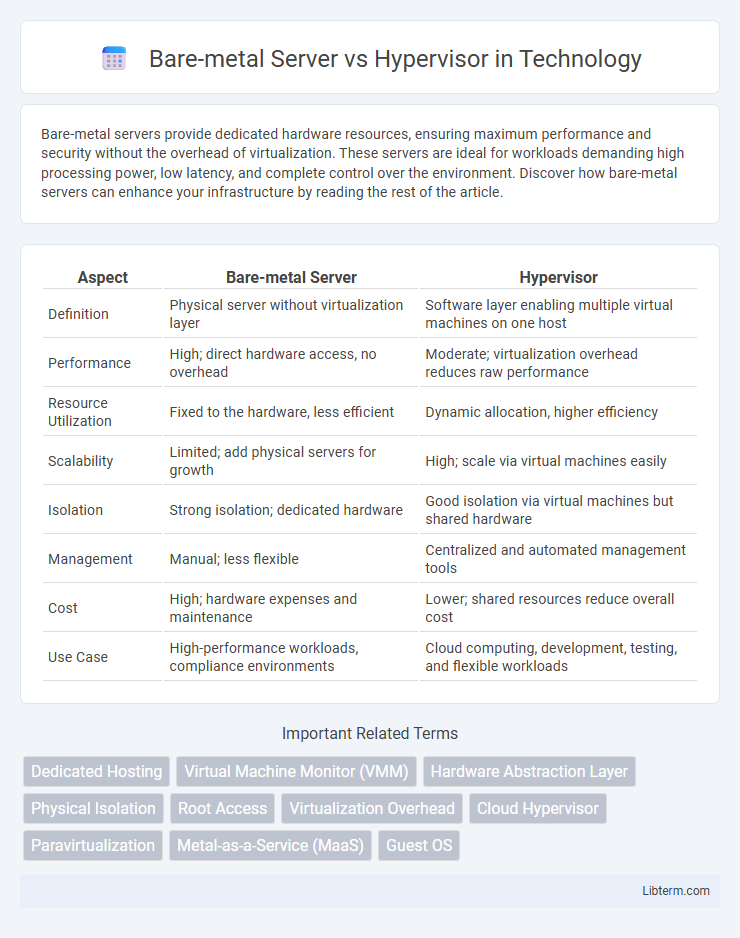Bare-metal servers provide dedicated hardware resources, ensuring maximum performance and security without the overhead of virtualization. These servers are ideal for workloads demanding high processing power, low latency, and complete control over the environment. Discover how bare-metal servers can enhance your infrastructure by reading the rest of the article.
Table of Comparison
| Aspect | Bare-metal Server | Hypervisor |
|---|---|---|
| Definition | Physical server without virtualization layer | Software layer enabling multiple virtual machines on one host |
| Performance | High; direct hardware access, no overhead | Moderate; virtualization overhead reduces raw performance |
| Resource Utilization | Fixed to the hardware, less efficient | Dynamic allocation, higher efficiency |
| Scalability | Limited; add physical servers for growth | High; scale via virtual machines easily |
| Isolation | Strong isolation; dedicated hardware | Good isolation via virtual machines but shared hardware |
| Management | Manual; less flexible | Centralized and automated management tools |
| Cost | High; hardware expenses and maintenance | Lower; shared resources reduce overall cost |
| Use Case | High-performance workloads, compliance environments | Cloud computing, development, testing, and flexible workloads |
Introduction to Bare-metal Servers and Hypervisors
Bare-metal servers provide dedicated hardware resources without a virtualization layer, enabling maximum performance, security, and control for demanding workloads. Hypervisors, such as VMware ESXi, Microsoft Hyper-V, or KVM, create and manage multiple virtual machines on a single physical server by abstracting hardware resources into isolated environments. Bare-metal servers are ideal for applications requiring full hardware access and predictable performance, while hypervisors optimize resource utilization by running multiple virtual instances concurrently on shared infrastructure.
Core Architecture Differences
Bare-metal servers run directly on physical hardware, providing dedicated resources without an intervening software layer, which maximizes performance and minimizes latency. Hypervisor-based systems use a virtualization layer to partition physical hardware into multiple virtual machines, enabling resource sharing and isolation but introducing overhead. The core architectural difference lies in bare-metal servers delivering direct hardware access versus hypervisors abstracting hardware to enable multiple virtual environments.
Performance Comparison
Bare-metal servers deliver superior performance by providing direct access to hardware resources without the overhead of virtualization layers, resulting in lower latency and higher throughput for intensive workloads. Hypervisors introduce abstraction and resource sharing, which can lead to performance degradation, especially under heavy load or I/O-intensive applications. In use cases demanding maximum CPU, memory, and storage efficiency, bare-metal servers consistently outperform virtualized environments managed by hypervisors.
Security Implications
Bare-metal servers offer enhanced security by providing isolated hardware environments, reducing the attack surface commonly exploited in hypervisor-based virtualization. Hypervisors introduce additional layers of software that can contain vulnerabilities, making them potential targets for hyperjacking and VM escape attacks. Organizations prioritizing data protection and regulatory compliance often prefer bare-metal servers for their direct hardware control and minimized risk of hypervisor-specific breaches.
Scalability and Flexibility
Bare-metal servers offer superior performance with direct hardware access, ideal for workloads requiring maximum scalability but often lack the flexibility of virtual environments. Hypervisors enable rapid deployment and resource allocation across multiple virtual machines, enhancing flexibility by isolating workloads and optimizing server utilization. Scalability in hypervisor-based systems allows for dynamic resource adjustments, supporting fluctuating demands without the need for physical hardware changes.
Resource Management
Bare-metal servers provide direct access to physical hardware, enabling highly efficient resource utilization without the overhead of virtualization layers, which leads to superior performance in CPU, memory, and I/O resource management. Hypervisors abstract and partition physical resources among multiple virtual machines, facilitating resource allocation flexibility, isolation, and scalability at the cost of additional management complexity and potential performance overhead. Choosing between bare-metal and hypervisor-based environments depends on the specific workload demands for resource control, with bare-metal favoring low-latency and high-throughput applications while hypervisors excel in multi-tenant and dynamic resource distribution scenarios.
Cost Analysis
Bare-metal servers typically involve higher upfront capital expenditure due to dedicated hardware purchases but offer lower ongoing costs through optimized resource utilization and minimal virtualization overhead. Hypervisor-based virtualized environments reduce initial hardware costs by enabling multiple virtual machines on shared physical servers, yet incur additional licensing fees, management complexity, and potential performance penalties that can increase operational expenses over time. Cost analysis should weigh factors like workload requirements, scalability needs, and total cost of ownership (TCO) to determine the optimal balance between bare-metal efficiency and hypervisor flexibility.
Use Case Scenarios
Bare-metal servers provide maximum performance and security by running directly on physical hardware, ideal for high-compute workloads, large databases, and applications requiring low latency such as financial trading platforms. Hypervisors enable multiple virtual machines to share a single physical server, optimizing resource utilization for development environments, testing, and multi-tenant cloud services where flexibility and scalability are critical. Enterprises deploying containerized applications and microservices benefit from hypervisor-based virtualized environments, while bare-metal servers suit mission-critical workloads with stringent performance and compliance demands.
Pros and Cons Overview
Bare-metal servers offer superior performance and dedicated resources, making them ideal for workloads requiring high reliability and low latency, but they lack the flexibility and scalability of hypervisor-based virtualization. Hypervisors enable multiple virtual machines to run on a single physical server, optimizing resource utilization and simplifying management, though they can introduce overhead and potential security vulnerabilities. Choosing between bare-metal and hypervisor solutions depends on workload requirements, cost considerations, and the need for isolation versus scalability.
Choosing the Right Solution
Bare-metal servers deliver direct hardware access, offering superior performance and security for high-demand applications, while hypervisors provide flexible virtualization enabling multiple operating systems on shared hardware. Selecting the right solution depends on workload requirements, with bare-metal ideal for intensive computing tasks, and hypervisors suited for scalable, multi-tenant environments. Consider factors like resource allocation, management complexity, and cost-efficiency to align server choice with business objectives.
Bare-metal Server Infographic

 libterm.com
libterm.com